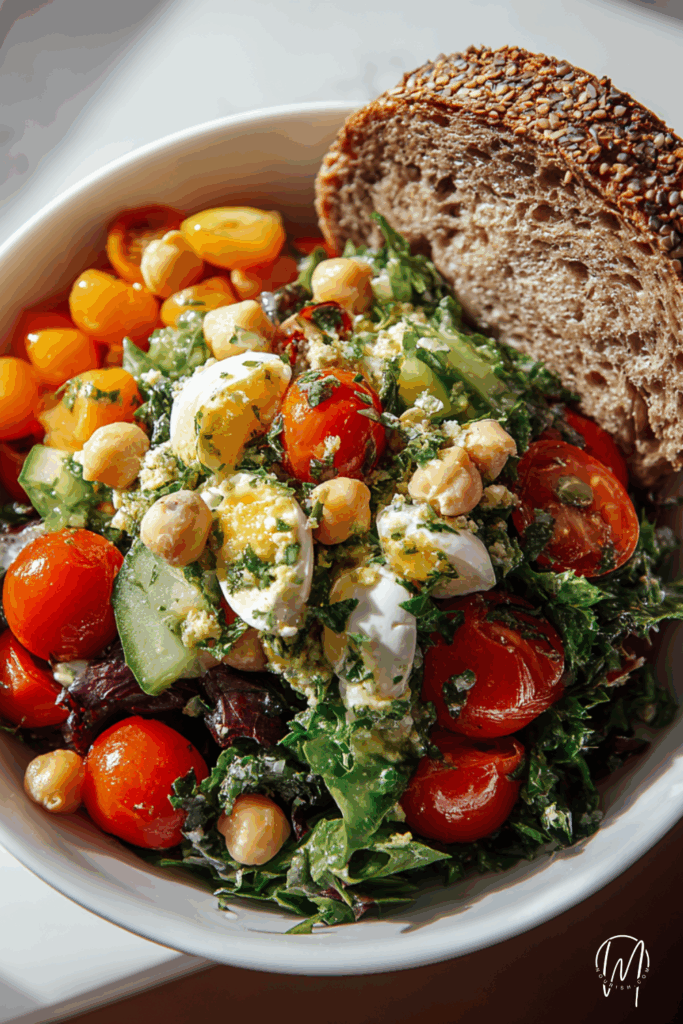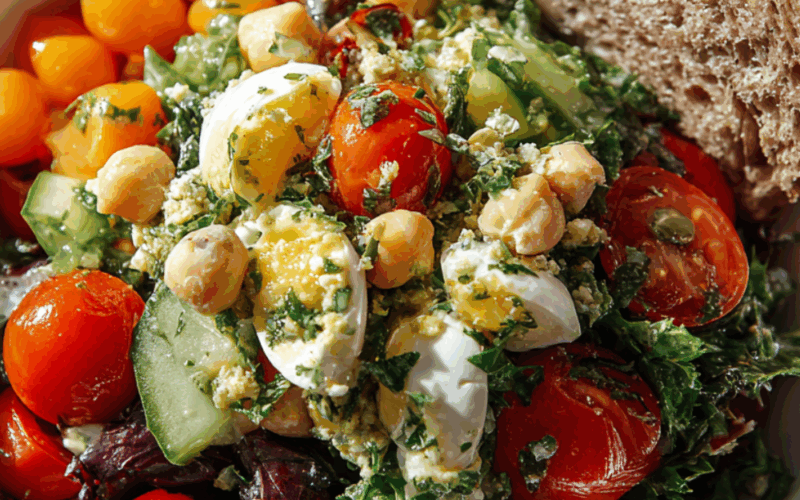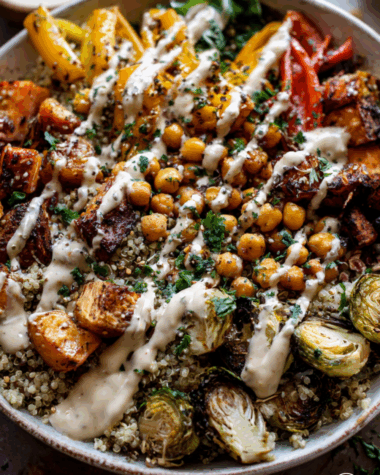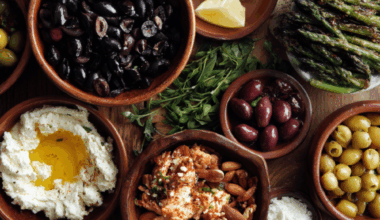The Mediterranean Diet is more than just a “diet” — it’s a pattern of eating rooted in tradition, flavor, and longevity. Inspired by the traditional food cultures of Greece, southern Italy, Spain, and coastal regions of the Mediterranean, this approach emphasizes plant-based foods, high-quality fats (especially olive oil), whole grains, seafood, and moderate dairy, while limiting red meat, added sugars, and ultra-processed foods (1).
Why this guide matters: with mounting scientific evidence linking Mediterranean-style eating to reduced risk of cardiovascular disease, metabolic disorders, cognitive decline, and better longevity, having a comprehensive, user-friendly “ultimate guide” becomes your go-to reference.
In this guide, you’ll find:
- What the Mediterranean Diet is & how it works
- Key food groups & recommended frequencies
- Health benefits backed by research
- Myths, variations, and who it’s for
- Tips for adopting it sustainably
- Sample meal ideas & planning strategies
Let’s dive in.
1. What Is the Mediterranean Diet?

More Pattern Than Prescription
Unlike restrictive diet plans with rigid rules, the Mediterranean Diet is a flexible pattern — emphasizing food quality, balance, and lifestyle. It doesn’t strictly enforce macronutrient ratios or calorie counting; instead, it guides you toward better food choices and meal habits (2).
It is often visualized as a Mediterranean Pyramid, which shows the frequency of food groups (daily, weekly, monthly) rather than the exact number of servings.
Core Components
| Vegetables, Fruits, Legumes | Base of the diet — eat daily and abundantly. |
| Whole Grains | Brown rice, oats, barley, whole-wheat bread/pasta. Minimize refined grains. |
| Olive Oil (Extra Virgin) | Often included moderately (e.g., one glass with meals), in cultural contexts. But not mandatory or recommended to start if you don’t already drink. |
| Nuts & Seeds | Eaten regularly as snacks or included in meals for healthy fats and fiber. |
| Fish & Seafood | Preferably fatty fish (salmon, sardines, mackerel) at least 2–3 times per week. |
| Poultry, Eggs, Dairy | Moderate consumption; focus on yogurt, cheese (often fermented) rather than heavy dairy. |
| Red Meat & Processed Meats | Limited to occasional use — often a few times per month. |
| Sweets, Refined Sugar, Ultra-Processed Foods | Minimized. The diet encourages these only rarely. |
| Wine (Optional) | Often included moderately (e.g., one glass with meals), in cultural contexts. But not mandatory or recommended to start if you don’t already drink. |
| Water & Herbal Teas | Often included moderately (e.g., one glass with meals), in cultural contexts. But not mandatory, and not recommended to start if you don’t already drink. |
Lifestyle is also integral: the Mediterranean way emphasizes regular physical activity, shared meals, mindful eating, and connection with nature and community.
2. How the Mediterranean Diet Works (Mechanisms)
Why does it support health? Here are the primary biological and physiological mechanisms:
Anti-Inflammatory & Antioxidant Effects
The diet is rich in plant-based polyphenols, vitamins, and carotenoids, which combat oxidative stress and reduce chronic inflammation. Olive oil’s polyphenols play a key role.
Healthy Fats & Lipid Profiles
Monounsaturated fats (mainly from olive oil) and omega-3 fatty acids (from fish) improve cholesterol, reduce LDL oxidation, and support cardiovascular health.
Improved Insulin Sensitivity & Blood Sugar Control
By emphasizing complex carbohydrates (whole grains and legumes) and fiber, the diet slows glucose absorption, supports stable blood sugar levels, and reduces the risk of type 2 diabetes.
Gut Health & Microbiome
High fiber and polyphenol intake promote beneficial gut bacteria, which influence metabolic and immune health.
Synergy Over Single Foods
One of the strengths of this diet is synergy: no single “magic food”, but the combination of foods working together confers benefit.
Longevity & Brain Function
Some research links a Mediterranean-style diet to slower cognitive decline, better memory, and a longer lifespan.
3. The Mediterranean Diet Health Benefits & Evidence
Here is a summary of well-supported benefits:
- Cardiovascular disease risk reduction: Strong evidence supports this diet’s protective effect on heart disease and stroke.
- Lowered mortality: Studies show higher adherence correlates with lower all-cause mortality.
- Reduced risk of metabolic syndrome and type 2 diabetes: Improved insulin sensitivity and weight control help.
- Better lipid profile & blood pressure
- Neuroprotective effects: Some associations with lower Alzheimer’s and cognitive decline risk
- Weight management: The diet is satiating yet nutrient-dense — helpful in sustainable weight control
- Anti-cancer potential: Associations exist, though evidence is more preliminary
- Better gut health/inflammation regulation
That said, effects depend on adherence, overall lifestyle, and baseline health.
4. Variations, Myths & Considerations
Variations
- Vegetarian / Plant-Forward Mediterranean: Exclude fish or meat, rely more on legumes, tofu, plant proteins
- High-Protein Mediterranean: Emphasize lean proteins more, while retaining the other foundational components.
- Gluten-Free Mediterranean: Swap in gluten-free grains (quinoa, brown rice) for wheat-based ones
- Low-Carb Mediterranean: Modify carbohydrate sources downward but maintain emphasis on quality fats and vegetables
Common Myths & Misconceptions of The Mediterranean Diet
- “It’s a low-fat diet.” No — total fat is moderate to liberal, but comes primarily from healthy sources.
- “You can eat unlimited olive oil.” Quality matters; overconsumption without calorie balance can lead to excess energy intake.
- “It’s just about fish and olive oil.” Ignoring vegetables, whole grains, legumes, and lifestyle components reduces the benefit.
- “Wine is required.” No — wine is optional. Its benefits are modest, but it comes with risks.
- “It’s only for older adults or of Mediterranean origin.” It’s adaptable and beneficial across populations when customized.
Who Should Be Cautious / Adaptations
- People with kidney disease or hyperlipidemia may need adjustments in protein or fat intake.
- Those allergic to nuts, fish, or other staples
- Calorie-sensitive individuals (need to monitor portions)
- Pregnant or lactating women— require adjustments
Consulting a dietitian before significant changes is wise.
5. How to Adopt the Mediterranean Diet: A Step-by-Step Roadmap
Here’s how to make it practical and sustainable:
Step 1: Audit & Replace
- Remove or reduce ultra-processed foods, sugary drinks, and refined grains
- Replace butter with olive oil; soft drinks with water or herbal teas
Step 2: Build Meals Around Plants
- Half your plate: vegetables and/or salad
- Add legumes, whole grains, and moderate lean proteins
- Use herbs, spices, lemon, and garlic to flavor
- Include nuts/seeds as snacks or toppings
Step 3: Fish & Lean Protein
- Aim for 2–3 servings of fatty fish weekly
- Use poultry, eggs, and dairy (yogurt, cheese) in moderation
- Limit red meat to occasional use
Step 4: Olive Oil as Your Fat
- Use extra virgin olive oil for cooking and dressing
- Drizzle on vegetables, use in marinades
Step 5: Portion & Frequency Guidance
- Use the Mediterranean Pyramid as a guide for frequency
- Let intuition, satiety, and hunger guide exact portions
Step 6: Embrace the Lifestyle
- Eat with others; slow down; enjoy the meal process
- Walk, move daily
- Sleep well, manage stress, connect socially
Step 7: Start Gradually & Be Flexible
- Aim for 80% adherence (some flexibility)
- Modify recipes rather than abandon favorites
- Track changes in how you feel to stay motivated
6. Sample Menu Ideas & Meal Planning for the Mediterranean Diet

Here’s a sample daily structure (≈2,000 calories, adaptable):
- Breakfast: steel-cut oats with walnuts, berries, and a drizzle of olive oil
- Snack: Greek yogurt with chopped nuts and fruit
- Lunch: salad with Mediterranean greens, tomatoes, chickpeas, vinaigrette (olive oil + lemon), whole-grain bread
- Snack: raw vegetables + hummus or a handful of raw nuts
- Dinner: grilled salmon (or sardines) + grilled vegetables + quinoa or farro
- Optional dessert: fresh fruit, a small piece of dark chocolate
For a 5-day example, see this dietitian’s plan.
Helpful tips: batch-roast veggies, cook grains in bulk, prepare simple dressings, freeze portions.
7. Common Challenges & How to Overcome Them
- Cost concerns: Buy seasonal produce, frozen vegetables, canned fish, shop smart
- Time constraints: Use sheet-pan meals, one-pot cooking, and planning ahead
- Cravings/transition: Allow occasional favorite moderate treats
- Social/cultural differences: Adapt your cuisine (e.g., Mediterranean-style swaps in your culture)
- Sticking power: Focus on small wins, consistency over perfection
8. Measuring Success & Adjustments
- Track metrics like blood lipids, blood pressure, energy, and weight (if relevant)
- Adjust calorie intake based on goals
- Customize for food intolerances, medical conditions
- Reassess periodically
9. Conclusion & Next Steps
The Mediterranean Diet is one of the most well-researched, sustainable, and flexible eating patterns available. Rather than being a strict regimen, it’s a way of life — one that harmoniously integrates vibrant, whole foods, healthy habits, and social connection.
Whether you’re new to it or refining your habits, use this guide as your pillar of reference. Break it into subtopics (e.g., olive oil, meal planning, variation guides), test recipes, adapt them to your culture, and focus on consistency over perfection.
Your next steps:
- Start small (swap some meals, reduce processed foods)
- Plan a week’s menu with Mediterranean principles
- Connect with a dietitian if you have medical conditions
- Use this guide as a navigation map for your Mediterranean journey


